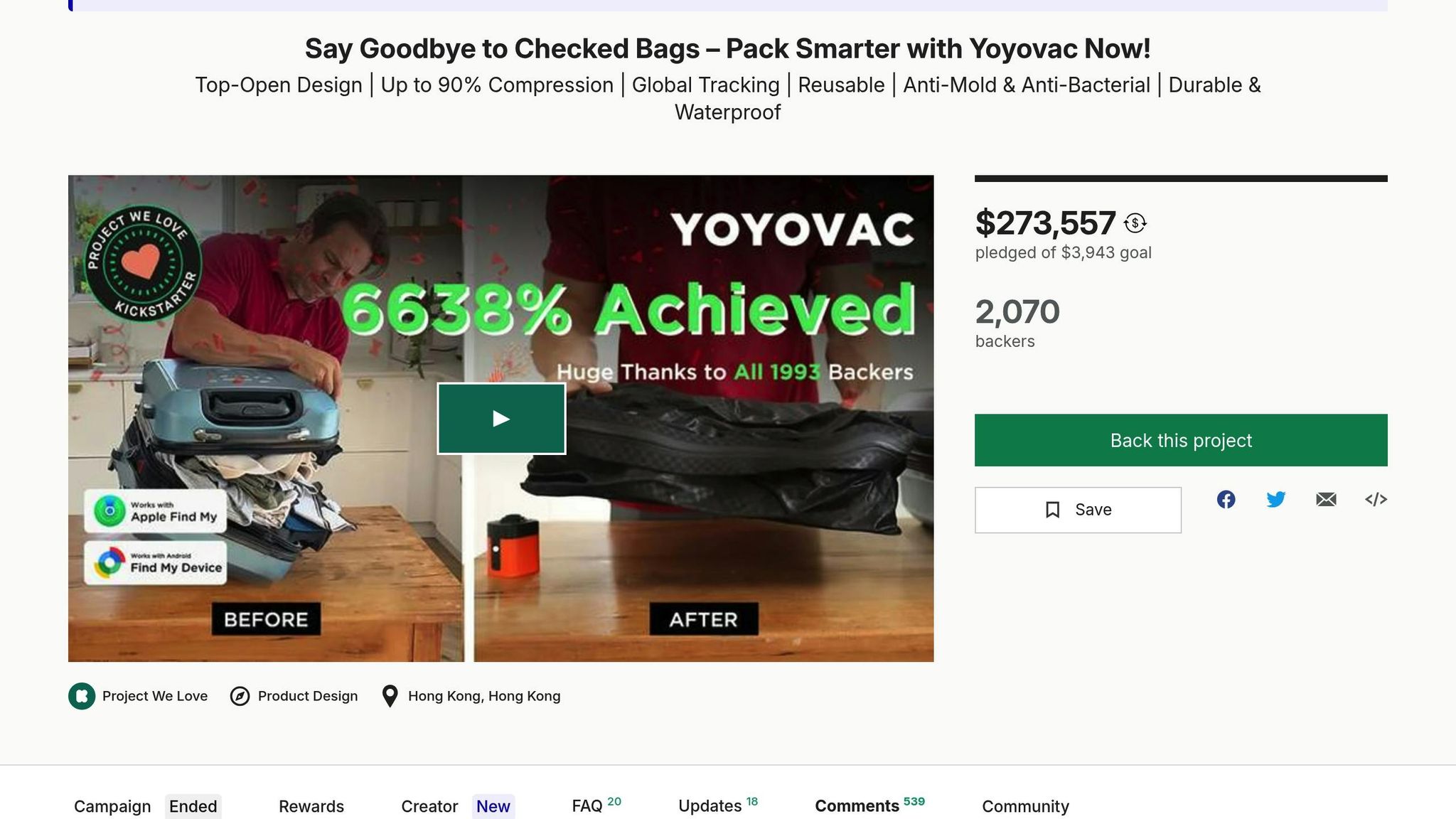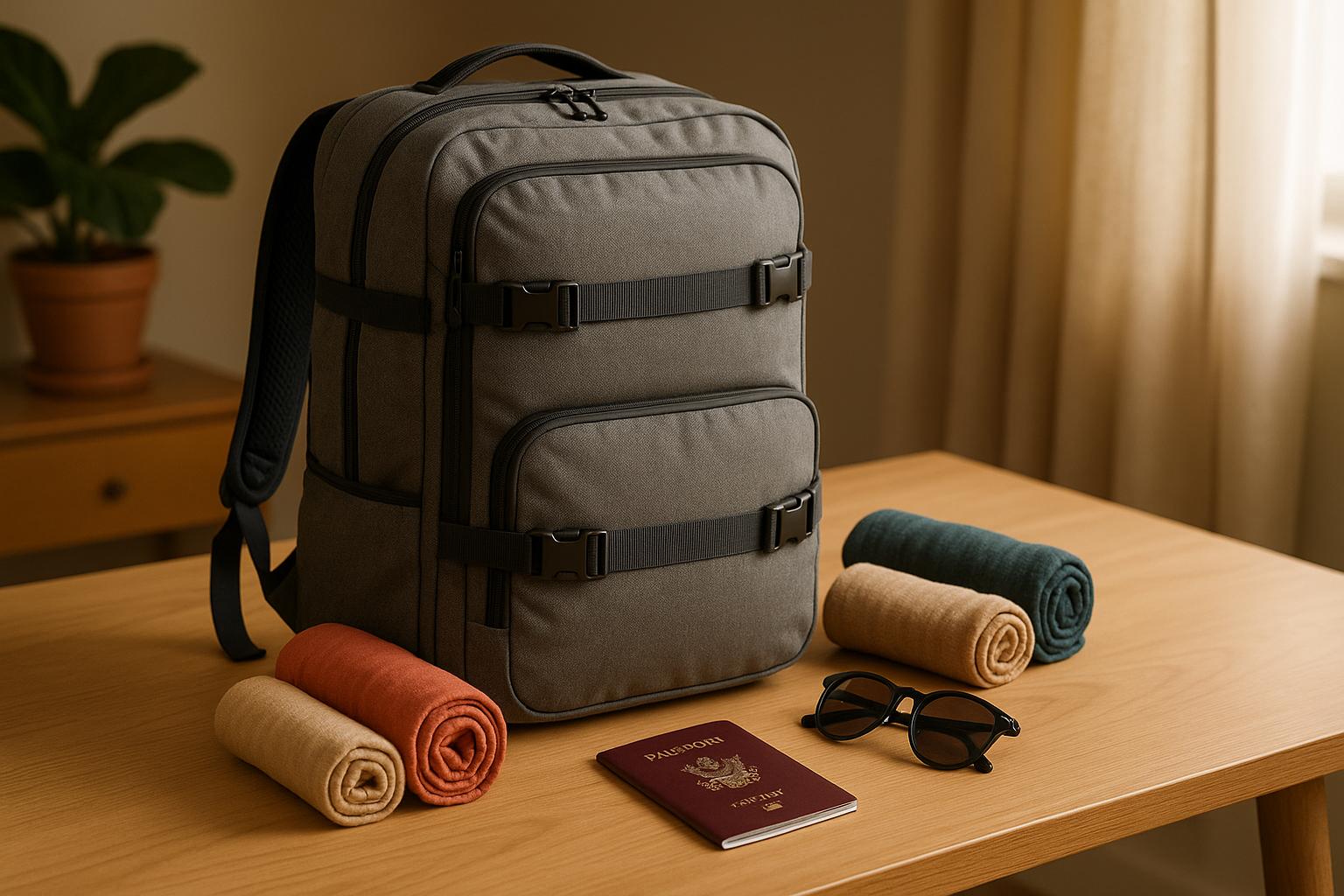Packing light is easier with compression systems. These tools can reduce the volume of your packed items by 30–60%, helping you fit more into your luggage and avoid overweight baggage fees. Here's how they work:
- Vacuum Compression: Removes air to shrink clothing volume by up to 80%.
- Better Weight Distribution: Creates a stable, evenly packed load for easier carrying.
- Less Need for Extra Padding: Dense packing protects items without adding bulky materials.
- Built-in Comfort Features: Ergonomic designs reduce strain and improve load stability.
- Space Limits Encourage Lighter Packing: Structured systems help you pack smarter and avoid overpacking.
Compression systems not only save space but also make travel more comfortable and efficient. Whether you're packing for a weekend trip or a long vacation, these tools can transform how you prepare for your journey.
ULTIMATE Space Saving Packing Hack! Yoyovac Vacuum Compression Bag Review

1. Vacuum Compression Removes Air Space
Vacuum compression works by removing air from fabric, significantly reducing the volume of clothing - sometimes down to just 20% of its original size [1]. This method doesn’t alter the weight of your items but makes packing far more space-efficient. For example, Titantrek's system eliminates air pockets while keeping fabric intact, allowing you to pack more without adding unnecessary bulk.
"My favorite part about this bag set is how effective the manual pump and valve was at sucking out air. I could see myself using this on a cold-weather vacation when I need to pack bulky items like sweaters, jeans, and coats and trust that it'll stay compact throughout the travel days." [3]
To get the best results with vacuum compression, consider these tips:
- Smoothly fold clothes to reduce wrinkles.
- Place heavier, bulkier items like jackets at the bottom.
- Avoid overstuffing to ensure the seal stays intact.
Tests show that vacuum compression systems can shrink clothing volume by up to 80% [2]. This feature is especially useful when you’re trying to meet tight carry-on luggage restrictions.
2. Better Weight Distribution Through Dense Packing
Dense packing isn't just about saving space - it’s also about achieving better weight distribution. When items are packed tightly together, their weight spreads evenly across your luggage instead of concentrating in one area.
Titantrek’s vacuum compression technology helps create a tightly packed core, reducing weight shifts during transit. This balanced packing approach improves stability and makes travel more comfortable.
Uneven weight distribution can make a load feel heavier than it actually is, increasing strain on your body [7]. By compressing items into a uniform density, the load stays centered and closer to your body’s core. This results in a more balanced and comfortable carrying experience.
Here’s why dense packing with compression is a game-changer:
- Less Stress on Your Luggage: Evenly distributed weight reduces pressure on zippers and seams, which can extend the life of your bag [6].
- Better Stability: Tightly packed items are less likely to shift around, keeping your bag stable during transit.
- Healthier Posture: With the weight evenly spread, it’s easier to maintain proper posture, even on long travel days.
For the best results, place heavier items at the center-bottom of your bag. This keeps the weight close to your body and minimizes fatigue [5]. Combined with compression, this technique ensures your luggage feels stable and moves as a single, cohesive unit rather than a jumble of shifting items.
3. Less Need for Extra Padding
Vacuum-compressed items create a dense, stable structure that reduces movement, cutting out the need for bulky padding materials like bubble wrap, foam inserts, or padded cases. This not only saves space but also avoids adding unnecessary weight. Thanks to Titantrek's technology, your packed items gain natural protection within your bag.
According to data from UNISCO Fulfillment Services, compression packaging has been shown to reduce damage rates by up to 30% compared to traditional packing methods [9]. In many cases, compression alone provides sufficient protection for a variety of items.
Tips for Compressing Clothing and Soft Items
Clothing and Soft Items
Vacuum compression is especially effective for clothing and other soft materials. By tightly packing these items, you create a natural barrier that eliminates the need for extra padding [1]. This method works particularly well for:
- Sweaters and jackets
- Blankets and bedding
- Casual clothing
- Athletic wear
Packing Considerations
To maximize protection without additional padding, keep these tips in mind [8]:
- Fabrics like cotton, spandex, and polyester compress easily and maintain their shape.
- Use thicker compression bags to reduce wrinkles.
- Avoid compressing natural fibers like wool, leather, and cashmere for long periods, as it may damage them.
- For extended trips, periodically air out compressed clothes to keep them fresh.
sbb-itb-b1567d8
4. Built-in Comfort Features
Advanced compression systems do more than save space and protect your belongings - they also enhance how loads are carried, making your journey far more comfortable.
Modern designs, like Titantrek’s vacuum compression backpacks, combine compression technology with ergonomic elements to evenly distribute weight. This reduces the strain of heavy loads, helping you feel less burdened while traveling.
Advanced Weight Distribution
Carrying a poorly distributed load - between 5% to 20% of your body weight - can significantly affect spinal alignment, reducing lumbar lordosis and increasing upper thoracic kyphosis [6]. To counteract this, Titantrek backpacks are designed with features that prioritize comfort and proper posture:
- Multi-panel airflow system for better ventilation
- 3D back padding to alleviate pressure points
- Adjustable shoulder straps for a tailored fit
- Supportive waist belt to shift weight to the hips
As Dr. Neel Anand notes, “Wearing a backpack improperly can pull the shoulders back, forcing an unnatural spine” [10]. Titantrek’s ergonomic design aims to prevent just that.
Improved Carrying Performance
The combination of compression technology and ergonomic features significantly enhances comfort during use:
| Feature | Function | Comfort Advantage |
|---|---|---|
| Vacuum Compression | Reduces volume by up to 50% | Improves load stability |
| Multi-panel Airflow | Boosts ventilation | Minimizes heat and sweat buildup |
| 3D Back Padding | Relieves pressure points | Promotes even weight distribution |
| Adjustable Straps | Allows a personalized fit | Optimizes load positioning |
Smart Load Management
Even carrying a light backpack - just 5% of your body weight - can increase oxygen use and heart rate [6]. To ease the strain, consider these tips:
- Pack heavier items close to your back.
- Adjust straps for a snug, secure fit.
- Use all available compression features.
- Ensure weight is evenly distributed.
These adjustments, paired with advanced compression systems, make every trip less tiring and more enjoyable.
5. Space Limits Help Pack Lighter
Fixed space limits aren't just about keeping your bag organized - they encourage smarter packing. By setting clear boundaries, you avoid overpacking and make the most of the space you have. Titantrek's compression system is designed to maximize efficiency while ensuring you stick to a manageable size. For the best results, aim to fill compression bags to about 70% of their capacity for optimal compression [11].
Practical Packing Strategy
Using a structured compression system can make a big difference in how efficiently you pack. Here's a quick breakdown of strategies to save space while keeping your belongings organized:
| Category | Space-Saving Technique | Benefit |
|---|---|---|
| Clothing | Roll items tightly before compressing | Reduces wrinkles and saves space |
| Bulky Items | Use larger compression bags | Shrinks their overall volume |
| Accessories | Store in smaller compartments | Keeps everything neat and tidy |
| Essential Items | Pack in easily accessible sections | Makes it easier to grab what you need |
Once your trip is over, take a moment to evaluate how you packed. This can help you refine your approach for next time.
Post-Trip Analysis
After returning, separate the items you used from those you didn’t. This simple step can help you identify what’s truly necessary for future trips and avoid carrying extra weight [12].
Maximizing Packing Efficiency
A thoughtfully packed compression backpack can hold more than you might expect. For example, you can comfortably fit:
- 6 t-shirts
- 2 pairs of shorts
- 1 pair of jeans
- 6 sets of underwear and socks
- 1 Turkish towel
Conclusion
Compression technology makes packing easier by optimizing how space is used. With clever designs and smart features, these systems help travelers pack more efficiently while keeping their luggage easy to manage.
"I can probably double the amount of things I can take. Clothes only, though - shoes still pose a significant issue" [4]
This quote highlights that effective packing isn’t just about saving space - it’s also about understanding what works best for compression.
For those on the go, Titantrek’s design isn’t just about saving room. It combines space efficiency with carry-on compatibility, offering waterproof materials and TSA-approved locks to keep your belongings secure and travel-ready.
Here’s a quick breakdown of what to keep in mind:
| Aspect | Benefit | Important Note |
|---|---|---|
| Clothing Type | Maximize compression | Works best with soft items like clothing |
| Weight Distribution | Balanced packing | Keep total weight within airline limits |
| Organization | Easy access | Compression helps keep items neatly arranged |
| Durability | Long-lasting use | High-quality materials ensure reliability |
FAQs
How do compression systems help reduce the weight and bulk of my luggage?
Compression systems, particularly vacuum compression bags, are a game-changer when it comes to packing. By sucking out the air from soft items like clothing, they can shrink the volume of your belongings by as much as 75%. While your items won’t weigh any less, the reduced bulk means you can pack more efficiently and fit everything into a smaller, more manageable bag.
This not only helps you dodge those pesky checked bag fees but also keeps you within airline carry-on size limits. Plus, your travel gear becomes much easier to handle. Compression systems let you pack smarter, so you can bring what you need without the hassle of oversized luggage.
Are there certain types of clothing or fabrics that shouldn’t be vacuum-compressed for long periods?
Not all clothing and fabrics can handle long-term vacuum compression. Materials like leather, silk, cashmere, and thick wool are especially vulnerable. Prolonged compression can cause these fabrics to wrinkle, lose their shape, or even suffer permanent damage. Their delicate nature makes them less likely to bounce back to their original condition after being unpacked.
To keep these pieces in good shape, opt for folding them neatly or storing them in breathable garment bags. This approach helps maintain their quality and ensures they stay in excellent condition, whether you're storing them at home or packing for a trip.
How can I keep my vacuum compression bag sealed securely while traveling?
To ensure your vacuum compression bag stays sealed and functions properly during travel, keep these tips in mind:
- Avoid overfilling: Leave a bit of space near the zip closure so the seal can close tightly.
- Check the zipper thoroughly: After sealing, run your hand along the zipper to make sure it’s completely closed.
- Pack clean, dry items: Ensure everything inside is dry to prevent any mold or mildew from forming.
- Tighten the valve: If your bag includes a valve, double-check that it’s securely closed after removing the air.
- Store in a cool, dry spot: This helps protect the bag and keeps it in good condition.
By following these tips, you can keep your travel gear compact, organized, and ready for the journey.

Vacuum Compression Bags vs. Standard Carry-On Packing
Best Backpacks for Multi-Device Storage